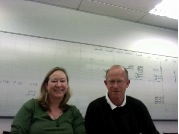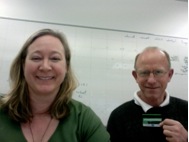Activity: Measuring with digital pictures
AOs |
Indicators |
Outcomes |
Snapshot |
Learning experiences |
Cross curricular |
Assessment |
Spotlight |
Links |
Connections
Purpose
Determine real size of objects from photos.
Achievement objectives
- GM6-1 Measure at a level of precision appropriate to the task.
- GM 6-5 Recognise when shapes are similar and use proportional reasoning to find an unknown length.
- NA 6-1 Apply direct and inverse relationships with linear proportions.
Indicators
- Selects appropriate units for measuring tasks.
- Identifies limits of accuracy for a measurement.
- Estimates sensibly.
- Understands the effect of the accuracy of a measurement on subsequent calculations, for example, measuring lengths and using these to find areas and volumes.
- Recognises similar shapes using their properties.
- Uses properties of similar shapes in solving problems:
- Matching lengths are proportional.
- Uses a variety of methods, for example, equations, tables and graphs, in solving ratios and percentages problems.
- Uses ratios in solving problems, for example, scale factor.
- Uses percentages in solving problems, for example, percentage of a quantity, expressing a ratio as a percentage.
- Uses rates, ratios and percentages in both directions, for example, inverse percentages (finding the original amount).
- Investigates situations involving relationships of the form y=kx.
Specific learning outcomes
Students will be able to:
- use scale factors to find lengths of objects.
TOP
Diagnostic snapshot(s)
See
'starter activity'.
Planned learning experiences
Starter
- As a class, or in groups, take digital photos (digital camera, computer (Apple Photo Booth), or phone) in class of people holding objects from various distances.
- Display photos and use measurements from the photo to determine the actual size of the object. (Clearly, they can’t be allowed to just measure the object, they may need to measure other items in the photo or make a best guess.)
- Compare class estimates. Who was closest?
This can be built on and developed further, see below.
Suggested implementation
If available, and as appropriate, have students bring phones with cameras to class. Have a few digital cameras (either student or school), or have teacher’s computer with photo capability. This could be done with only one digital camera.
Students work in groups of two or three.
- Have 8-15 of the same sized objects available for the class, for example, toothpaste boxes.
- Let students take any photos they want as long as the full shape is visible somewhere in the photo.
- Collect in all the objects (remove them from the room or hide under desk).
- Collect all photos and load on to the teacher’s computer.
- Display photos and use measurements from the photos to determine the actual size of the object? (Clearly, they can’t be allowed to just measure the object – that is why you removed it.) This should generate a lot of discussion and hopefully students will come up with strategies on how to solve the problem, such as using a
'fixed item of reference' (see below).
For example, How wide are the glasses? How tall is the white board?

Teachers pic1
|

Teachers pic2
|
Questions: What are the issues that come up? How can these issues be addressed?
Some ideas: What if the item is closer to the photo or further away? What if we use zoom to go in further?
Have a fixed item of reference
If there is an object in each photo that is a fixed size then we can use scale to measure any other object in the photo. For example, include a student ID in the photo (in the same plane with the object to be measured).
- Retake one of the photos from the class with a Student ID in the photo.
For example:

Teachers pic3
Question to students: How do you use measurements from the photo to determine the actual size of the object?
One solution: Enlargement/scale factor
- Measure the actual and image width of the student ID.
- Measure the image width of the glasses (object to determine length of in photo).
- Now bring the objects back and compare to actual measurements. (Consider % error.)
Click to view additional photos that could be used with the class.
Possible adaptations to the activity
What if we change the aspect ratio (width:height) on the photo (so width and height aren’t kept in the same ratio)?
Pick one photo:
- Measure height and width of the same photo displayed at different sizes to bring awareness of aspect ratio.
- Talk about scale size of displayed photo. (Measurement for these things - %, aspect ratio, width, height - can be displayed if the photo is embedded in MS Word; click on 'format picture' and look at the size tab.)
The effect of depth: if some objects in the photo are further back from the fixed object, how does that effect the measurement?
TOP
Cross curricular links
Photography
Planned assessment
This teaching and learning activity could lead towards assessment in the following achievement standards.
Spotlight on
Pedagogy
- Encouraging reflective thought and action:
- Supporting students to explain and articulate their thinking.
- Engaging students in evaluating different methods and strategies.
- Facilitating shared learning:
- Students working in groups and having learning conversations.
- Providing sufficient opportunities to learn:
- Using an engaging starting point for learning.
- Recognising effort and perseverance.
Key competencies
- Thinking:
- Students select appropriate methods and strategies when solving problems
- Students use mathematics to model real life and hypothetical situations, they challenge assumptions and thinking and engage in sense making
- Using language, symbols and texts:
- Students understand and communicate information and ideas using mathematics.
- Relating to others:
- Students share their ideas, accept a range of approaches, and respect others’ thinking.
Values
- Students will be encouraged to value innovation, inquiry, and curiosity, by thinking critically, creatively, and reflectively.
Māori/Pasifika
Planning for content and language learning
- Include opportunities for monitoring and self-evaluation:
- Am I using 'think alouds' to show students my strategy use?
- What opportunities are there for reflection and self-evaluation?
Links
Connections
- Lowe, I. (1991). Creating an image. Mathematics at work - Modelling your world: Volume 1 (p. 285). Canberra, ACT: Australian Academy of Science.
Download a Word version of this activity:
Last updated May 9, 2022
TOP




